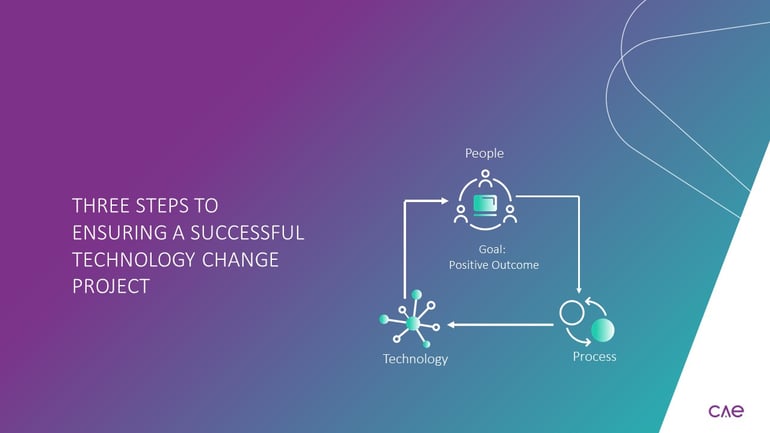
Technology on its own will not transform a business or lead to productivity improvements. It’s all too common within businesses these days to believe that the latest technology will lead to improved productivity, more streamlined processes and higher employee engagement. The old “if you build it they will come” adage – if we implement this new tech all our problems will be solved. This rarely if ever proves true, and often results in under-utilised technology, employee resistance and a shadow IT culture.
When looking at any business transformation or change project, many organisations fail to realise they are taking on far more than just a technology project. As businesses, we must fundamentally change how we measure technology implementation projects' success and recognise the importance of people being at the heart of every project.
People, Process and Technology - alignment of all three is crucial to success.
 In this blog, our Head of Marketing, Louise Mahrra explores the fundamentals behind People, Process and Technology and how to overcome common obstacles faced when these three key areas are overlooked.
In this blog, our Head of Marketing, Louise Mahrra explores the fundamentals behind People, Process and Technology and how to overcome common obstacles faced when these three key areas are overlooked.
People
Change is hard! Technology can facilitate an increase in a business’s revenue and growth, but you have to bring people along with you and focus on user adoption of technology and how you will implement this.
To truly achieve success and realise the full potential of any technology is dependent on the adoption of it by your users. Technology can transform the way your business operates and can lead to significant business results. But, this ability can only be realised if users willingly change the way they work. And users will only change the way they work if they are aware of the benefits they will receive (this is commonly referred to as the WIIFM clause, ‘what’s in it for me?’).
The most successful technology implementation projects rely on a user adoption programme; one that first listens to and understands people’s needs and requirements and brings them on a journey to adopt a new way of working. Dispel myths, avoid rumours and break down the “fear of the unknown” by talking to people frequently about the who, what, when, where, why and how of the change. When people can personally relate to the change and understand the value of the technology, they are more likely to adapt and adopt the change. By building trust early, you help prepare users for what's coming and identify early adopters. These early adopters, in turn, become your brand ambassadors for change.
The first step to ensuring a successful technology change project: Put people at the heart of your project – understand how they do their jobs to enable you to communicate the benefits of a new way of working. Communicate change early and frequently.
Process
![]() Defining business process outputs and success metrics is a crucial element of implementation success. By nature, technology changes often bring a degree of structure; existing processes can be made more efficient, improved or even changed altogether.
Defining business process outputs and success metrics is a crucial element of implementation success. By nature, technology changes often bring a degree of structure; existing processes can be made more efficient, improved or even changed altogether.
Take the time to ensure you and your technology implementors understand the current internal structures in your organisation and the ways that people do their daily jobs – sometimes the perceived least important element of someone’s daily way of working gets over-looked and can lead to a process breakdown later down the line, all because that person wasn’t consulted and their role/process was not fully understood. Technology tools can help you to discover the way people get things done, and where process bottlenecks are, without forcing them into inflexible processes.
The second step to ensuring a successful technology change project: Encourage people to participate in the ongoing improvements and business process design. Any technology implementation or change programme should allow people to determine the process, not vice versa.
Technology
Why doesn’t technology on its own lead to an increase in efficiency? The most common pitfalls are substandard user interface design, confusing user experience or badly crafted processes (usually a combination of all three!) It is for this very reason that we always stress the importance of aligning People, Process and Technology.
![]() Technology needs to be aligned to the needs of the users; it is much more important and beneficial in the long run to put the right technology into the hands of the right people in the right way and at the right time.
Technology needs to be aligned to the needs of the users; it is much more important and beneficial in the long run to put the right technology into the hands of the right people in the right way and at the right time.
To improve technology adoption and usage, you first need to understand how people are doing things and the current state of play in the business. Using analytics tools and services will give you a holistic view of your business's capabilities and allow you to manage your business change project with minimal impact on your end users while ensuring a smooth transition from old to new.
The third step to ensuring a successful technology change project: When evaluating new technology, start from the most basic level. What's not working, what can be expected to change with newly implemented technology, and how will success will be measured?
If your organisation is considering investing in technology, take the people, process and technology approach to maximise your chances of achieving both a successful implementation and the business benefits you were hoping for.



